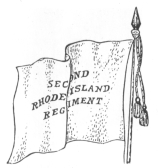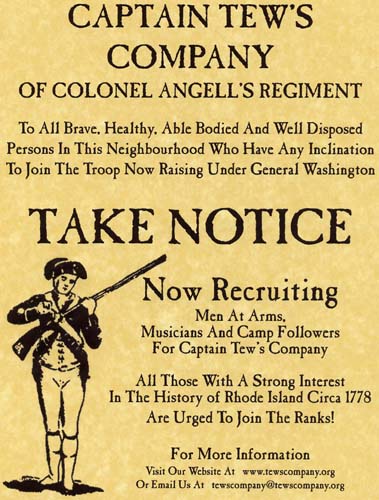
of Colonel Angell's Regiment

Captain Tew's Company has been reformed to commemorate the role played by Rhode Island soldiers in the American Revolution. The recreated company is composed of men and women who portray the Revolutionary War soldier and his military camp as "living history". A volunteer organization, the members of the company come from many backgrounds but all share a deep, common respect for the American War for Independence. Tew's Company is a member of the Continental Line.
Each member of Tew's Company is personally responsible for uniforming and equipping himself in order to duplicate the attire of the company. The unit strives to portray the Company during the campaign season of 1778. Around the beginning of June 1778 the Regiment was issued overalls, hats, and hunting frocks as it left Valley Forge. Before that time, most if not all of the brown red-faced coats have worn out, descriptions of civilian cloths and a probable Hessian coat description exists. So the primary uniform of that period is the white/natural split front hunting frock over well-worn civilian, or the odd tattered Hessian coat, if any coat at all with waistcoat of either civilian or military style and white/natural overalls. The hats are cocked and white taped. Specific equipment requirements will be based on current research. Members are strongly encouraged not to have facial hair. Thus clothed, armed and equipped, Tew's Company goes into the field dressed in precisely the same manner as did his Revolutionary predecessor.
Tew's Company strives to provides an insight into the daily routine of the Revolutionary War soldier and his camp followers. Marching drills and the manual of arms are executed in accordance with Von Stuben's regulations. As a flank company Tew's also incorporates open order drill as did all of the Rhode Island Continentals. Meals are prepared over cooking fires using reproductions of the pots and kettles of the eighteenth century. To these mainstays of reenacting we strive to add other aspects of camp life including the artificer core.
We also do a later war interpretation to show the similarities and differences between different periods of the war. This interpretation is from the period of the Rhode Island Regiment, when the 1st and 2nd regiments were combined, Captain Stephen Olney's Light Infantry Company of Lieutenant-Colonel Jeremiah Olney's Battalion, 1781. Under our Capt. Olney's Company interpretation we are members of the Brigade of the American Revolution.

Anyone with a strong interest in the American Revolution and the
time to devote to this avocation is welcome to seek membership. The minimum
age for members using firearms is sixteen. Musicians and non shooters are
eligible at twelve years.
Since authenticity is a vital requirement the Company makes every
effort to guide each member in the preparation of his equipment.
For further details contact Capt. Tew's Company at

tewscompany@tewscompany.org.
Here is the 2003 Schedule.
Here is the 2004 Schedule.
Here is the 2005 Schedule.
Here is the 2006 Schedule.
Here is the 2007 Schedule.
Here is the 2008 Schedule.
Here is the 2009 Schedule.
Here is the 2010 Schedule.
Here is the 2011 Schedule.
Here is the 2012 Schedule.
Here is the 2013 Schedule.
Here is the 2014 Schedule.
Here is the 2015 Schedule.
Here is the 2016 Schedule.
Here is the 2017 Schedule.
Here is the 2018 Schedule.
Here is the 2019 Schedule.
At the end of 1776 the Continental Congress decided each Colony would supply a number of regiments, dependent on the colony's population. Rhode Island would supply two regiments. Due to the difficulty of recruiting new regiments each year the men of these units would sign on for 3 years or the rest of the war. The officers of the 1st Rhode Island Regiment mostly came from the 9th Continentals of 1776 which was a descendant of Varnum's 12th Continentals of 1775. The officers of the 2nd Rhode Island Regiment mostly came from the 11th Continentals of 1776 which was a descendant of Hitchcock's 14th Continentals of 1775. In the early 1778 the privates of the 1st Rhode Island Regiment were transfer to the 2nd Rhode Island Regiment and the officers of the 1st were sent home to recruit the "Black Regiment". In the beginning of 1781 the Rhode Island Regiments were combined into the Rhode Island Regiment, with the officers with the longest commission retained.
The 2nd Rhode Island Regiment was a administrative name and units were commonly named for the commanding officer, this was Colonel Israel Angell. In 1777 the regiment was formed with 8 companies, this was changed to 9 in 1779, the first commanded by Captain William Tew. So this unit strives to portray an experienced unit, hardened by a winter at Valley Forge, and ragged for lack of supplies, but crack drilled in the "new" drill from Baron Von Stuben.
In the summer of 1777, Angell's Regiment (2nd RIR) along with Col. Christopher Greene's Regiment (1st RIR), 4th Conn., and 8th Conn., were put under the command of Brigadier-General James Mitchell Varnum to form Varnum's Brigade. The author of Private Yankee Doodle, Joseph Plumb Martin was a private in the 8th Conn. at the time. The Rhode Islander's had there own journaler Jeremiah Greenman who starts the war as a Private and ends it as a Lieutenant. In the fall of 1777 the brigade was sent to the defense of Philadelphia, where the units participated in the defense of Fort Mercer and Fort Mifflin. In the Spring of 1778 the 1st RIR is sent home to recruit and drops out of the brigade. After the Battle of Monmouth the brigade is broken up. For the Battle of Rhode Island Varnum is given another brigade consisting of the 1st and 2nd RIR, Sherburne's, Webb's, Livingston's, and Jackson's battalions. After the British leaves Rhode Island in October 1779 Varnum retires form Continental service and the 2nd RIR is put under John Stark until its amalgamation with the 1st RIR.
Officers and enlisted men
from Col. Angell's Regt. took part in many of
the major engagements of the war as this list shows;
Siege of Boston, June 1775 - March 1776,
Expedition to Quebec,
September - December 1775,
Long Island, N.Y., 27 August 1776,
Harlem Heights, N.Y., 16 September 1776,
White Plains, N.Y., 28 October 1776,
Second Trenton, N.J., 2 January 1777,
Princeton, N.J., 3 January 1777,
Red Bank (Fort Mercer), N.J., 22 October 1777,
Valley Forge PA, Winter of 1777-1778,
Barren Hill, PA, 20 May 1778,
Monmouth, N.J., 28 June 1778,
Rhode Island, 29 August 1778,
Springfield, N.J., 23 June 1780,
Green Springs, Va., 6 July 1781,
Yorktown, Va., October 1781,
and Forts Herkimer & Oswago.
Below is short history of 2nd RIR reproduced for the community
History taken from "A Short History of the 2nd Rhode Island Regiment of the Continental Line", by Roy P. Najecki, 1983.
The following is a compilation of John Chillson service and the actions of the Second Rhode Island Regiment.
A bibliography of sources.
Small assortment of pictures of the recreated unit.
more picturesLinks to other Revolutionary War Re-enacting home pages.
Links to historical sites.
If you have additional sources of information on the RI regiments,
and/or original members of the regiments,
we would be happy to hear about it for possible inclusion on our web site.
We make every effort to reference our sources and would link to relevant
web pages.
tewscompany@tewscompany.org
Due to the changing nature of the cable industry our web address keeps changing so we have gotten a domain name to give ourselves a fixed place to be found. If you have not gotten to us trough our domain name http://www.tewscompany.org/ please link or bookmark to it because the ATTBI address will be changing in the near future. Thank you.